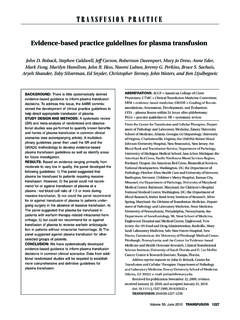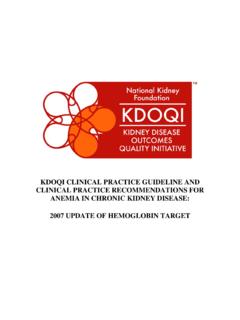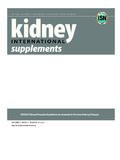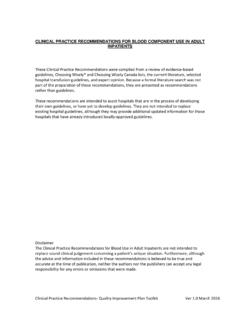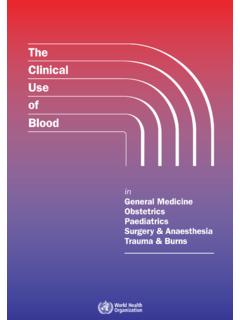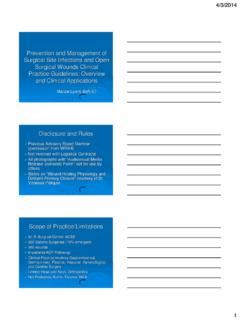Transcription of Clinical Transfusion Practice - WHO
1 Clinical Transfusion Practice Guidelines for Medical Interns ii Foreword Blood Transfusion is an important part of day to day Clinical Practice . Blood and blood products provide unique and life saving therapeutic benefits to patients. However, due to resource constraints, it is not always possible for the blood product to reach the patient at the right time. The major concern from the point of view of both user (recipient) and prescriber (clinician) is for safe, effective and quality blood to be available when required. Standard practices should be in place to include appropriate testing, careful selection of donors, screening of donations, compatibility testing, storage of donations for Clinical use, issue of blood units for either routine or emergency use, appropriate use of blood supplied or the return of units not needed after issue, and reports of Transfusion reactions all are major aspects where standard practices need to be implemented.
2 In order to implement guidelines for standard Transfusion practices , a coordinated team effort by clinicians, blood Transfusion experts, other laboratory personnel and health care providers involved in the Transfusion chain, is needed. Orientation of standard practices is vital in addressing these issues to improve the quality of blood Transfusion services. Bedside clinicians and medical interns are in the forefront of patient management. They are responsible for completing blood request forms, administering blood, monitoring transfusions and being vigilant for the signs and symptoms of adverse reactions. These guidelines are intended to enhance the implementation of standard Clinical Transfusion practices for improved patient safety. iii Acronyms AHF Antihaemophilic factor APTT Activated partial thromboplastin time DAT Direct antiglobulin test DIC Disseminated intravascular coagulation FFP Fresh Frozen Plasma Hb Haemoglobin HBV Hepatitis B virus Hct Haematocrit HCV Hepatitis C virus HDN Haemolytic disease of the newborn HIV Human immunodeficiency virus ITP Idiopathic autoimmune thrombocytopenic purpura MOHFW Ministry of Health and Family Welfare MTP Massive Transfusion protocol PC Platelet concentrates PRBC Packed red blood cells PT Prothrombin time PTT Partial thromboplastin time SRO Statutory Regulation Order TACO Transfusion associated circulatory overload TA GVHD Transfusion associated graft versus host disease TR Transfusion reaction TRALI Transfusion related acute lung injury TTIs Transfusion transmissible
3 Infections TTP Thrombotic thrombocytopenic purpura iv Table of Contents Foreword iii Acronyms iv 1 Introduction 7 Principles of Clinical Transfusion Practice 7 Safe blood 7 2 Screening of blood donations 9 Steps in blood screening 9 Blood safety in the hospital setting 9 Blood donor recruitment 9 Blood collection 10 3 Blood components 11 Whole blood 11 Red cell concentrates / packed red blood cells 12 Platelet concentrates 12 Fresh frozen plasma 13 Cryoprecipitated antihaemophilic factor 14 4 Storage of blood components 16 5 Clinical Transfusion procedure 17 Indications for blood Transfusion 17 Transfusion trigger 17 Responsibility of attending physician 17 6 Administration of blood products 19 Blood request form 19 Blood samples 19 Red cell compatibility testing 20 Collection and receipt of blood 20 Performing the Transfusion 22 Monitoring the Transfusion 23 Documentation of the Transfusion 23 Other aspects of Transfusion 24 Warming blood 24 Use of medication at time of Transfusion 25 Use of fresh blood 25 7 Adverse effects of Transfusion 26 Guidelines for recognition and management of acute Transfusion reactions 28 Investigating acute Transfusion reactions 29 Haemolytic Transfusion reaction 30 Bacterial contamination and septic shock 31 Transfusion associated circulatory overload 31 v Anaphylactic reaction 31 Transfusion related acute lung injury 31 Delayed complications of Transfusion 32 Delayed haemolytic Transfusion reaction 32 Post Transfusion purpura 32 Transfusion associated graft versus host disease 32 Delayed complications.
4 Transfusion transmitted infections 33 8 Massive blood Transfusion 34 9 Transfusion in Paediatrics 36 Top up transfusions 36 Exchange Transfusion 37 Haemolytic disease of the newborn 38 ABO haemolytic disease of the newborn 39 Transfusion of platelets and FFP in paediatric patients 39 10 Blood Transfusion Services in Bangladesh 43 Tables Table 1: Suggested rates of Transfusion 22 Table 2: Duration times for Transfusion 22 Table 3: Category 1: Mild reactions 28 Table 4: Category 2: Moderately severe reactions 28 Table 5: Category 3: Life threatening reactions 28 Table 6: Parameters in massive Transfusion investigation and monitoring 34 Figures Figure 1: Blood cold chain from collection to Transfusion 16 Figure 2: Check points for signs of deterioration in blood and plasma 21 Figure 3: Hazards of blood Transfusion 27 Figure 4: Cross match report form 40 Figure 5: Transfusion notes 41 Figure 6: Management of adverse Transfusion reaction: physician s notes 42 7 1 Introduction It is well known that errors in blood Transfusion practices can lead to serious consequences for the recipient in terms of morbidity and mortality.
5 The majority of errors occur due to incorrect sampling of blood from a patient, fetching the wrong unit of blood for a patient and transfusing blood inappropriately. These Clinical Transfusion guidelines describe protocols for the collection of blood samples for blood grouping and cross matching, and for the collection, storage and administration of blood and blood products. The guidelines provide a standardized approach to Transfusion so that the potential for errors is minimized and the administration of safe and efficacious blood products in the health care setting is maximized. They also contain protocols for the investigation and treatment of adverse Transfusion reactions and provide guidelines for the use of specialised blood products. Principles of Clinical Transfusion Practice The patient with acute blood loss should receive effective resuscitation (intravenous replace ment fluids, oxygen and other medication) immediately and the need for Transfusion is estimated thereafter.
6 The patient s haemoglobin (Hb) value, although important, should not be the sole deciding factor in the decision to transfuse blood. This decision should be supported by the need to relieve Clinical signs and symptoms and to prevent significant morbidity or mortality. Clinicians should be aware of the risk of Transfusion transmissible infections in blood products prescribed for patients. Transfusion should be prescribed only when the benefits to the patient are likely to outweigh the risks. Clinicians should clearly record the reason for ordering a Transfusion ( Clinical diagnosis). Trained staff should monitor a patient undergoing Transfusion and respond immediately there are signs of an adverse effect. Safe blood Blood for Transfusion is considered safe when it is: Donated by a carefully selected, healthy donor Free from infections that could be harmful to the recipient Processed by reliable methods of testing, component production, storage and transportation Transfused only upon need and for the patient s health and wellbeing The quality and safety of blood and blood products must be assured throughout the process from the selection of blood donors to the administration of blood into the patient.
7 This is described in the WHO Blood Safety Initiative: Establishment of a well organized blood Transfusion service with quality system in all areas. Collection of blood only from voluntary non remunerated donors from low risk populations, using rigorous procedures for donor selection. Screening of all donated blood for Transfusion transmissible infections HIV, HBV, HCV, syphilis and malaria. 8 Good laboratory Practice in all aspects of blood grouping, compatibility testing, component preparation and the storage and transportation of blood and blood products. Reduction of unnecessary transfusions through the appropriate Clinical use of blood and blood products and the use of simple alternatives to Transfusion when possible. Transfusion of blood and products should be undertaken only to treat a condition that would lead to significant morbidly or mortality and that cannot be prevented or managed effectively by other means.
8 9 2 Screening of Blood Donations Blood screening began in Bangladesh in 2000 at all hospital based blood Transfusion centres. It is the process that starts with the recruitment of safe blood donors and is followed by the mandatory screening for five Transfusion transmissible infections (TTIs) which includes HIV, Hepatitis B, Hepatitis C, syphilis and malaria. Testing for TTIs started under the purview of the Safe Blood Transfusion Act 2002, which states that prior to Transfusion , all blood and its products must undergo testing. The objective of screening is to detect markers of infection, and prevent the release of infected blood and blood components for Clinical use. The assay selected for screening should be highly sensitive and specific. The aim is to detect all possibly infected donations while minimizing wastage due to false positive results.
9 Reactive donations that are confirmed positive, or in which results are indeterminate, should be discarded using methods in accordance with standard safety precautions. Steps in blood screening Physical Screening Blood donor selection Self exclusion, deferral Laboratory testing - Detection of infection markers; either antibody or antigen Blood safety in the hospital setting Low risk blood donor recruitment Blood screening Rational use of blood Blood donor recruitment It is recommended to collect blood from non remunerated volunteer donors. The aim of using selection guidelines for blood donors has two purposes: firstly, to protect donors from potential harm which may occur as a direct result of the donation process; secondly, to protect recipients of blood Transfusion from adverse effects, such as transmission of infectious diseases or other medical conditions and unwanted effects caused by medication taken by the donor.
10 In Bangladesh, donors are selected according the following important eligibility criteria: General appearance: the prospective donor shall appear to be in good physical and mental health. Age: donors shall be between 18 and 60 years of age. Haemoglobin: Hb shall be not less than g/dL for males and g/dL for females. Weight: minimum 45 kg. Blood pressure: systolic and diastolic pressures shall be normal (systolic: 100 140 mm Hg and diastolic: 60 90 mm Hg is recommended), without the aid of anti hypertensive medication. Temperature: oral temperature shall not exceed Pulse: pulse shall be between 60 and 100 beats per minute and regular. Donation interval: the interval between blood donations shall be 3 to 4 months. 10 Blood collection The donor should not be fasting before donation. If the last meal was taken more than four hours previously, the donor should be given something to eat and drink before donation.










